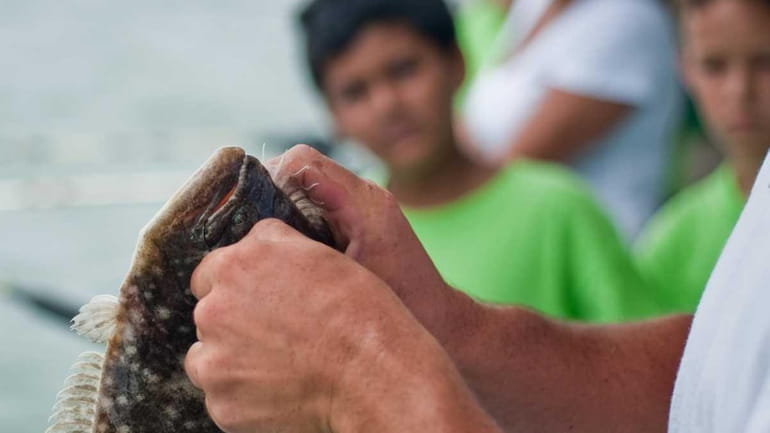A freediver sees world of change down below

A crew member takes a hook out of a fluke that is too small to keep. The Police Athletic League hosts its annual summer fishing trips for kids. (July 13, 2011) Credit: Steve Pfost
The bottom paved with black sea bass, plenty of short fluke, dramatically increased numbers of triggerfish along with greater numbers of more southern visitors like grey triggerfish, cobia and croaker, Long Island anglers will tell you this is what they see in our inshore waters these days. Mike Laptew says he's certain they are right.
A freediver (diving without tanks) and underwater cinematographer/photographer who has explored the coast from the Mid-Atlantic states to Maine, Laptew, like many Long Island anglers, is amazed, intrigued and disturbed by changes he's seen the past few years.
"I've been diving for over 50 years," he told me recently, "and the changes are similar from New Jersey right up to Maine. With an increase in water temperature there has been a northern push of species. Triggerfish were once rare in these waters but now they are common, the same goes for black sea bass which infest areas like the Long Island Sound. We now see cobia and red drum every summer, and there are so many croaker and spot in some places that skippers use them for bait. In Salem, Massachusetts, which never had a squid fishery, a tackle shop two years ago sold $20,000 worth of squid jigs because the calamari just showed up out of the blue."
Like many anglers, Laptew believes that climate change is driving the northern migration of traditionally southern fish species -- and he thinks that fishery management regulators are having a tough time adjusting for all the changes.
"It's amazing the havoc a small degree of climate change can cause," says the 64-year old from North Kingstown, Rhode Island. "In Narragansett Bay, for example, winter water temperatures have increased two or three degrees. This has allowed a shrimp that normally migrates to deeper water in the colder months when winter flounder spawn to stay in the bay and predate on baby blackbacks."
"It's hard to make good regulatory decisions with these changes going on," says Laptew, "especially when laws mandate Draconian changes based on data that fisheries regulators admit is sometimes flawed. We need more flexibility in our management options. We need to get better at this, and fast."
That seems especially true in the case of fluke. Last week the Mid-Atlantic Fishery Management Council (MAFMC) and Atlantic States Marine Fisheries Commission (ASMFC) voted to impose a 29 percent reduction in our regional quota starting with the 2016 season. This is better than the 43 percent reduction originally discussed, but it will still result in plenty of pain for fluke fans in New York, New Jersey and Connecticut, which share the same quota. Essentially, it means that we'll see some combination of reduction measures that might include a larger size limit, smaller creel limit and shorter season. Any way you cut it, "ouch" is one of the nicer four-letter words anglers are likely to mumble.
As for Laptew, "the diving fisherman" will continue taking underwater photos and videos, presenting them in the hope of educating the public about what is going on beneath the surface. His work is beautiful, thought provoking and timely. You can see it at The White Room Gallery in Bridgehampton, Sept. 8 through Oct. 5. You can also visit www.mikelaptewfineartimages.com.
Email: outdoortom@optonline.net
